

Micro Macro

VINCENT PIGNO
A MICROSCOPE, AND THE world it reveals, cover the back of Vincent Pigno, a self-described “fledgling mathematician.” Among the things one can see with a microscope is a bacteria-infecting virus, called a bacteriophage, on Pigno’s left shoulder. Of course, a microscope lit by reflected sunlight wouldn’t quite be up to that particular challenge. Bacteriophages were first seen in the 1940s, thanks to the invention of more powerful scanning electron microscopes. Before then, many scientists doubted that bacteriophages even existed. Today, we know them to be the most common form of life on Earth, numbering an estimated 1031 all told—that is, ten thousand billion billion billion.
“Ninety percent of the time when I show it to people they say ‘Oh! A telescope!’” writes Pigno. “I generally don’t correct them.”
Eukaryote
GREG MOTZ, a postdoctoral researcher at the Ovarian Cancer Research Center at the University of Pennsylvania, wears a cutaway view of a cell on his shoulder—a present to himself for graduating with a degree in biology.
The tightly packed sacs and folded sheets on his tattoo are the hallmarks of eukaryotes— a group of organisms that includes millions of species, such as animals, fungi, plants, and amoebae. The two other major groups of species on Earth— bacteria and archaea—are microbes of far smaller dimensions. The interiors of their cells are far less complex. Bacteria and archaea are like sheds; eukaryotes are like mansions.
The ancestors of today’s eukaryotes probably started out roughly similar to bacteria and archaea. Their first great change took place when they swallowed up an oxygen-consuming species of bacteria. Perhaps they engulfed the bacteria as prey. Maybe the bacteria invaded as parasites. Whatever the case, the two cells became partners. The bacteria provided energy to their host cell, which provided them with shelter and a steady supply of nutrients. The bacteria lost many of the genes they needed for living on the outside. Eventually, they evolved into the sausage-shaped structures in Motz’s tattoo, known as mitochondria. Eukaryotes started carrying dozens of mitochondria in each cell, giving them the energy to grow gigantic. Into that space grew folds, sacs, and vast genomes. The first eukaryotes evolved over two billion years ago. Their origin was the first great leap in the size of life. Later, some lineages evolved groups of eukaryote cells that stuck together, growing big enough to be seen with the naked eye, big enough to thunder across the land, or to tower into the sky.

GREG MOTZ
Urchin

TROY ROEPKE
“I STUDIED SEA urchin development for my dissertation,” writes Troy Roepke, who is now a post-doctoral researcher at Oregon Health and Science University.
“Upon completion, I awarded myself this tat for my academic achievement. The tat is of a sea urchin egg, two-cell embryo, blastula, gastrula, prism stage and pluteus larval stage. Or as my friends say, an orange developing into an Alien face-grabber.”
Tadpoles
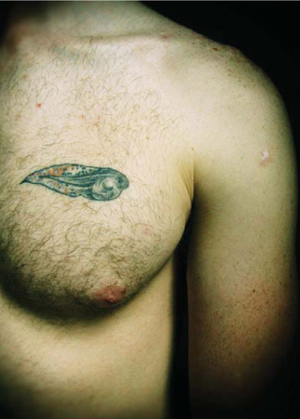
MATT MICHEL
M ATT MICHEL, a post-doctoral researcher at Saint Louis University, spent graduate school studying tadpoles and thinking about fate. Like humans, frogs carry genes that encode the proteins their bodies will make. The genes in a fertilized frog egg will steer its development into a tadpole, and then into an adult. Different versions of those genes will give rise to frogs of different sizes, different color patterns, different temperaments. And yet frogs are not merely the sum of their genes. Their experiences can transform them so drastically that they can take on the appearance of another species.
Gray treefrogs lay their eggs in small pools, where they are sometimes attacked by hungry dragonfly larvae. Where there are no dragonflies, the tadpoles rapidly develop hindlegs and grow a thin, grey tail. But if dragonflies are attacking their pond, the tadpoles delay the growth of their legs, develop a massive tail, and take on dark red spots. As best as scientists can tell, the tadpoles can detect some chemical trace of the dragonflies in the water, which triggers a new growth pattern.
This flexibility looks to be an adaptation driven by natural selection. Frogs that develop the thin pale tails grow faster than the red-tailed ones; but in predator-hassled ponds, the red-tailed tadpoles are more likely to survive. The red spots may camouflage the frogs; it’s also possible they direct dragonflies to their expendable tails, rather than their essential head and vital organs. The size of the tail probably lets them swim away faster from an attacking dragonfly.
All animals seem to have this kind of flexibility programmed into their genes. The conditions human mothers experience while pregnant can alter their children, influencing their height, their weight, and even their personality. This flexibility does not detract from the power of genes; in fact, it expands that power, because our genes aren’t just restricted to churning out the same traits regardless of what’s happening around them. They can pivot and leap.
“For visual purposes, I shaved my chest for the photographs,” writes Michel. “However, the presence of chest hair is actually relevant, because for my graduate research, I determined the effects of structural complexity (mostly aquatic vegetation) on the phenotypic responses of tadpoles. I found that structure did not affect these responses, and, appropriately, the presence of chest hair does not change the shape or color of the tattoo.”

Haeckel
D ARWIN PROPOSED THAT life had evolved like a growing tree, with each major group of species a separate branch. But it was up to a German biologist named Ernst Haeckel to make the first ambitious attempt to draw that tree, reclassifying all of life according to its evolutionary history rather than trying to force it into the artificial boxes of taxonomists. Haeckel even drew Darwin’s tree, a majestic specimen rising from bacteria at its base to mammals and other animals at its top.
There is much about Haeckel to criticize. He shared the racism often common to his time and place in the mid-1800s and early 1900s, and he gave it a pseudoscientific gloss by designating new species of humans. Unsurprisingly, he placed “Homo germanicus” high above “Homo africanus.” Haeckel was also responsible for the notion that ontogeny recapitulates phylogeny—which he called the Biogenic Law. He argued that new body plans evolved through the addition of new steps to the development of old ones. Haeckel made it a seductive idea, and many naturalists of his day accepted it. But today scientists can see that new steps can be added to the beginning or the middle of development as well as the end. In other words, the Biogenic Law is indeed true—except when it’s not.
Despite Haeckel’s shortcomings, many of his accomplishments still abide. He brought the ocean’s vast diversity of animal life to the world’s attention, both through his descriptions and through his marvelous artwork. Over ninety years after his death, his starfish and radiolarans grace many a scientist’s body.
Shell

KATE DECOSMO
KATE DECOSMO, a student at Florida State University, with Fusus longicauda, a species of sea snail.
Starfish
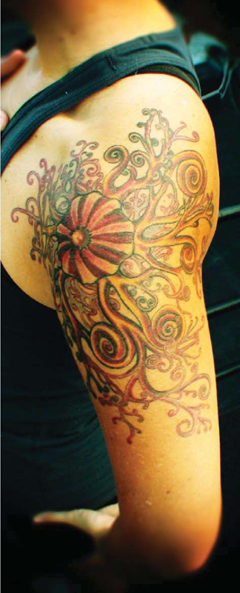
BRONWEN RICE
BRONWEN RICE, who works in the office of education at the National Oceanographic and Atmospheric Administration, with a basket starfish.
Jelly Fish
DAVE WOLFENDEN a lecturer in Animal Science at Reaseheath College in England, with a jellyfish.

DAVE WOLFENDEN
Tubularian
NATSHA MITCHELL a science radio host an Australian National Radio, with a tubularian, related to jellyfish and anemones.

NATASHA MITCHELL
Radiolarian
ANTHONTY JURD of Australia wears the image of a radiolarian—an amoeba-like creature that extends its tentacles through holes in its spherical armor.

ANTHONY JURD
Brittlestar
C HARLES DELWICHE, a professor at the University of Maryland who studies photosynthesis, wears a brittlestar.
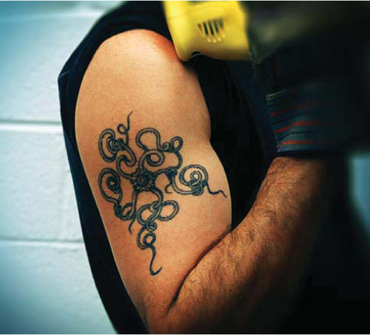
CHARLES DELWICHE
Diatom
D IATOMS, LIKE THE one worn by Richard Marinos, are single-celled algae that ornate shells from silica.
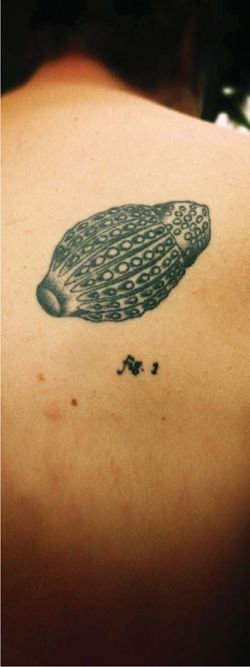
RICHARD MARINOS
Siphonophores

ALLEN COLLINS
“I N OUR CASE, my wife and I got tattoos as our wedding rings,” writes Allen Collins, a zoologist at the Smithsonian Institute. “I can still hear the guffaw of one of my wife’s good friends at the wedding when it was announced what we did. Our tattoos are ankle rings composed of a siphonophore, deep sea relatives of the Portuguese man-o-war. We modeled it after one of Haeckel’s plates, but have since been told by the guy who knows more about siphonophores than anyone else alive that it ‘doesn’t exist.’ That is one aspect for which it is not an apt symbol.”
Fungi

REX BARTLETT
“F UNGI ARE BEAUTIFUL,” writes Rex Bartlett, who harvests mushrooms for restaurants and farmers markets. “I’m not.”
Someday fungi will get their due. They represent one of the great kingdoms of the eukaryotes, totalling an estimated five million species. In fact, the fungal kingdom and the animal kingdoms are closer to each other than to any other kingdom of species. Our common ancestor, a singlecelled marine creature that lived 1.2 billion years ago, gave rise to two lineages, each of which evolved into multicellular species. We animals evolved bodies into which we swallowed our food to digest it. The fungi, on the other hand, evolved enzymes they could spew out, digesting their food on the outside.
Fungi came ashore before we did. They formed a partnership with the first land plants, performing chemistry on rocks and soil to supply the plants with minerals, while the plants supplied them with sugar made with sunlight.
Some fungi today are single-celled molds. But others became magnificently multicellular on their own terms. We see their bodies only occasionally, when they send up their fairy-tale toadstools and puffballs. But hidden away in the ground are networks of fungi, made of miles of threads, which can grow into the largest organisms on Earth.
Chloroplast

CHARLIE ROWHER
“I AM A SCIENTIST at the University of Minnesota,” writes Charlie Rowher.
“In 1999, as an undergrad on a plant science internship, a friend and I were sitting on our dorm roof, wondering what the best nerdy science tattoo would be. The double helix down the leg or back was suggested, but we concluded that a chloroplast was a better fit for our scientific interests. As the photoncollecting organelle in plants, it’s the source of energy for nearly all plant life and a fascinating biochemical machine. At that point in our careers, we found something that would represent our fascination with plants, no matter what field we chose to pursue. He is in botanical education (and didn’t go through with the tattoo). I’m in horticulture.”
Fungi are not the only partners on which plants depend for their success. Within their cells, they house tenants that help as well. Like us, they trapped oxygen-consuming bacteria that became mitochondria, which generate energy from sugar. But to get that sugar in the first place, plants forge together water and carbon dioxide, using sunlight to power the process. And all that takes place in lozenge-shaped chloroplasts. Like mitochondria, chloroplasts have wisps of DNA. And that DNA helps expose their true identity: they are former bacteria, captured a billion years ago by algae, and passed on to every plant alive today.
Grass
“K ANSAS IS FILLED with open fields full of prairie grass that blows free in the wind,” writes Kristina Lewis, a graduate student in environmental studies. “I moved to Kansas to attend school from a small town in upstate New York. I knew I wanted my first tattoo to be of prairie grass after one of my school labs where we spent all day working in it. To me, my tattoo of prairie grass, Kansas, and attaining my bachelors degree represents a time and experience that has allowed me to be more free in life; just as the prairie grass blows freely.”
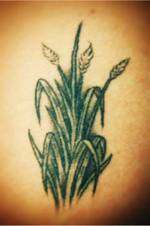
KRISTINA LEWIS
Passionflower
S HERRIE EMERINE is a weed scientist, but her tattoo, the passionflower (Passiflora incarnata) is not a weed. At least it’s not a plant recently introduced to the United States. Passionflowers have been spreading their vines across North America for many thousands of years. Passionflowers have a rare ability among native plants: it can invade farm fields and become a pest.
“I chose it because the plant is really lovely and the flowers are botanically unique, and because it fulfills many of the requirements for ornamental plants, but has the benefits of native species, such as providing food for insects, birds, and other wildlife, which is very important to me,” writes Emerine.

SHERRIE EMERINE

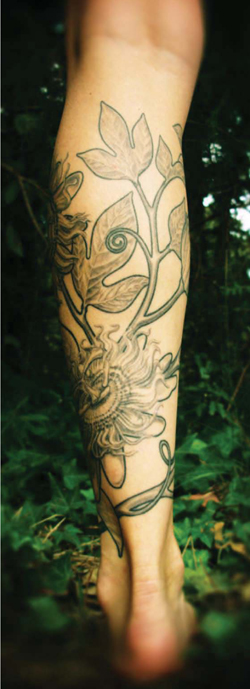
Jellyfish
AMY LAMB, who works at a zebrafish research facility at duke University, wears a jellyfish along her side. faceless brainless, jellyfish drift in the ocean currents. but beneath their rubbery bell, they hide biological complexity. They have a nervous system that does not feed signals in to a central brain; instead, their spikes of voltage race around the entire animal, and, collectively, they spur the jellyfish to rise, to sink, to lash out after prey. Some neurons in this web produce light-senstive receptors. And some species even have clumps of these neurons that form eye-like globes. Jellyfish can see, in other words, even if there is nowhere for their visions to go, except around and around.

AMY LAMB
Tardigrade
K RISTAL MCKELVEY, who now works in the pharmaceutical industry, spent time in college studying microscopic animals known as tardigrades. “I discovered three new species to science, and this tattoo is to represent how much I enjoyed that research. Also, I think tardigrades are some of the coolest organisms on Earth— they’re practically indestructible!”

KRISTAL MCKELVEY
Tardigrades make the world their hiding place. They live invisibly in the ground, in the muck of ponds and deep-sea sediments, in dunes, in moss, in stone walls, on the tops of mountains, and deep inside glaciers.
They go unnoticed thanks to their miniature dimensions: the biggest tardigrades don’t get bigger than a poppy seed. When the naturalist Johann A.E. Goeze discovered tardigrades in 1773, he dubbed them kleiner Wasserbär, meaning little water bear. Their stocky bodies and stumpy legs do give them an ursine cast, but there aren’t many bears that have eight legs, or daggers in their mouths that pierce smaller animals or algae cells.
There are also aren’t many bears that could be taken aboard a spacecraft, left out in the vacuum of space for ten days, and still be alive when they returned to Earth. But tardigrades have made this journey. Here on Earth, they can survive without water by going into a state of suspended animation. Even after nine years, a splash of water can revive them. No one is quite sure how tardigrades manage all this. Some experiments hint that they can turn their bodies into a liquid that’s as hard as a solid. Scientists call it biological glass.
Gastropods
A NDREW THALER, a graduate student in marine biology at Duke University, sports a pair of gastropods, deep-sea relatives of terrestrial snails and slugs. “I call it ‘the balance of the deep.’ Two hydrothermal vent endemic gastropods to commemorate my first deep-sea cruise. The one on the top is Alviniconcha hessleri and the one on the bottom is Ifremeria nautilei.”
In the cold blackness at the bottom of the ocean, gashes in the Earth release a bath of boiling mineral water. Giant mats of bacteria grow on their flanks, along with giant tube worms, crabs, shrimp, and many other species, isolated in underwater islands. These gastropods are among this group of bizarre species. They have no algae or plants to feed on. Instead, they play host to bacteria, which live in special organs inside the snails, where they feed on chemicals spewed out of the vents. The snails then feed on the bacteria, like carnivorous houses.
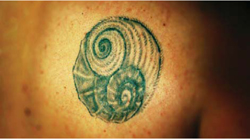
ANDREW THALER
Squid

REBECCA MENSCH
Bug Lady

SARAH FARRIS
SARAH FARRIS is an insect neurobiologist at West Virginia University, studying the evolution and structure of bug brains.
“I am obsessed with invertebrates, the subjects of most of my tattoos (OK, the fish are honorary invertebrates due to similarities in diversity and overall aesthetic value).
The tattoos started out as a hobby during grad school, as the semi-monthly tattoo appointments were something to look forward to amidst the stresses of completing my dissertation. Since I got the full sleeves, it’s pretty hard to hide the tattoos at work, especially during the summer. So I just let them show. No complaints yet.”
Ant
“I ’VE ALWAYS BEEN passionate about ants,” writes Antoine Felden, a biologist at the University of Toulouse in France. “Before I was able to walk, I spent most of my time on all fours to look at them. So it was natural, after high school, to start studying them. So I chose to take biology majors in Toulouse (France) and I finally ended up doing a small research project in an ant-specialized lab on the Cal campus. There, my passion for ants met the Californian way of life, and this tattoo is the baby. It’s on my wrist, looking to my hand, symbolizing a forward movement to more scientific discoveries.”
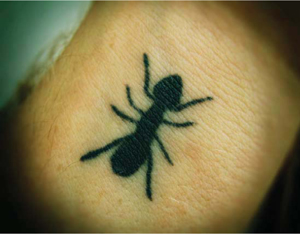
ANTOINE FELDEN
Fig Wasp
FIG TREES GROW throughout the tropics, looming overhead in many of the world’s rain forests. Like most other flowering plants, they have to have sex to reproduce. The female flowers on a tree must be fertilized with the pollen from male flowers of another tree in order to develop into seeds. But it’s hard to imagine how this can happen when you look at a fig. This tree’s male and female flowers both grow inside the fruit, sealed away from the outside world.

GREG MOTZ
The fig tree’s secret is a tiny wasp. A female wasp lands on a fig and digs its way inside, her wings stripping off along the way. She lays eggs inside the fruit and dies. When her eggs hatch, the larvae feed on the fruit and then develop into adults. The wingless male and the winged female wasps mate, after which the males dig a tunnel out of the fruit. The males die not long after they emerge from their fig womb, but the females take flight, covered with pollen from the fruit’s male flowers. The females seek out trees of the same species, and when they crawl inside a new fruit, the pollen on their bodies brushes up against the female flowers.
This tattoo of a fig and its wasp belongs to Greg Motz, a postdoctoral researcher at the Ovarian Cancer Research Center at the University of Pennsylvania. “I started out my educational path completely uncertain, and mostly uninterested,” writes Motz. “I was seriously going to be German Literature major, but I was also always interested in the sciences and did pretty well in those courses. At some point early in college I was reading a book by Richard Dawkins (I think Climbing Mount Improbable), and came upon the story of fig wasp. I was so totally enamored with the story of this tiny wasp, its symbiotic relationship with the fig tree, and the entire complex evolutionary and organismal biology of the wasp and tree. Reading this story was extremely powerful to me, and solidified in my mind that I would be a scientist. So, the tattoo is a constant reminder of why I chose to go down the path I did and maybe even forces me to reflect once in a while about the utter beauty and complexity of the natural world.”
White Mariposa

DENISE O’MEARA
“MY TATTOO IS of a flower called White Mariposa lily,” writes Denise O’Meara, a graduate student in molecular ecology at Waterford Institute of Technology in Ireland. “It occurs in Idaho, Montana, Nevada, Oregon, Utah, Washington and Wyoming. I first came across the flower as an ecology undergrad when I was fortunate to intern with the Nature Conservancy on the Zumwalt prairie in northeast Oregon. The huge expanse of rolling hills, teeming wildlife and beautiful wild flowers was like nothing I had ever seen or experienced growing up in Ireland. My time there has inspired me to further my education in conservation and I am currently pursuing a postgrad in conservation genetics. The tattoo is a reminder of the root of my passion for conservation and natural beauty.”
Frog
“I STARTED COLLEGE as an art major but always found myself drawing bones,” writes David Laurice, a grade-school science teacher. “The one structure that continued to come into my work was the skeleton of Rana pipiens [northern leopard frog]. I had memorized it from my high school biology textbook and a model my teacher had. The more I thought about it, the more I drew it, and learned about other structures. In any event, the compulsion eventually led me to what I call an ‘old school’ biology degree, as I became a natural historian and comparative anatomist. I had to forego all the prestige of taking the molecular route, and instead resigned myself to a desk as a teacher. Poor old Rana, laying on a tray at my side waiting to inspire another kid to be a biologist.”

DAVID LAURICE
Turle
RICK MACPHERSON, the director of the Coral Reef Alliance, chose a turtle tattoo based on an image of a sea turtle carved into volcanic rock throughout the Hawaiian islands. Honu, as the sea turtle was called, was believed to be created by drawing marks on rocks near the water. Honu swam into the ocean, but because it was part earth, it had to return to land to lay its eggs. “The Honu has a place in Hawaiian myth and legend as a messenger, a monster sent to attack enemies, a living canoe that transports lovers to each other, and even as the foundation of some of the islands,” writes Macpherson.
The sea turtles of Hawaii have lost many of their nesting sites to coastal development. Their eggs are devoured by the nonnative rats, dogs, and pigs. And the turtles themselves are killed in fishing nets. The most commonly sighted species around Hawaii, the green sea turtle, has been designated as threatened, and thanks to conservation and education, its numbers have been recovering in recent years.
“However, a relatively new mystery and threat has proven more challenging to solve,” writes Macpherson. “Over the past two decades, many Hawaiian sea turtle individuals have been plagued with a papilloma virus that causes disfiguring tumors on any soft portion of the turtle’s body.” The source of the outbreak is still a mystery, but several studies suggest that pollution is suppressing the turtles’ immune systems. “So the ancient Hawaiians may have been correct in seeing the Honu as messenger,” writes Machperhson. “Perhaps fibropapillomaafflicted sea turtles are trying to tell us that contamination of our coastal waters has reached a tipping point.”

RICK MACPHERSON
Boa
“I AM A COMPUTER programmer and amateur herpetologist,” writes Maggie Owens. “On my leg is Henry, a North Brazilian boa constrictor. This photo is so special, since he’s posed very much the way he came out on my leg, tongue and all. It’s not like I could give him instructions on what to do.”
This picture led me to do some research on the North Brazilian boa constrictor. The one paper I discovered was from, of all places, The Archives of Ophthalmology. It is worth quoting at length:
“An 18-year-old man was bathing his pet snake, a 6-ft-long North Brazilian boa constrictor (Boa constrictor), when it attacked him and bit him on the right eye. The snake had infectious stomatitis, a bacterial infection in the mouth. When the snake struck, the patient partially blocked the attack with his right hand; however, the snake was able to engage the patient’s right eye with its lower teeth, and his hand with its upper teeth. It would not release its bite and tried to wrap around the patient’s neck. The patient managed to telephone a neighbor, who dialed 911, and the police arrived. The policeman who answered the call, however, was ophidiophobic (fear of snakes) and was unable to lend assistance. The fire department arrived shortly thereafter, and a fireman, using a large knife, cut the snake’s head from its body. The multiple small recurved teeth could not be disengaged, so the patient was transferred to a nearby emergency department with the snake’s head attached to his eye.”

MAGGIE OWENS
After getting the hole in his eye sewn up and taking some antibiotics, the man recovered. Let that be a lesson: take care when you give your snake a bath.
Motmot
WHEN LYNNETTE DORNAK took an ornithology class in college, she fell in love with birds in general, and a bird order called the coraciiformes in particular. This group of species includes kingfisher, rollers, matmots, and bee-eaters. Her first glimpse of a belted kingfisher probably set her on her career as an orithologist. “I was in awe of their seemingly giganatichead and laughing cackle,” she writes.
Although she now studies more mundane sparrows as a graduate student of the University of Kansas, she decides to get a coraciiform tattoo. She ended up with a blue crowned motmot, in honor of the one she spoted on a solo backpacking trip through panama in 2008.

LYNETTE DORNAK
Swamp
MAUREEN DRINKARD has spent years mucking through Ohio bogs as she earned a Ph.D. at Kent State University, and so she decided to document the experience. “The extended exposure to methane gases and gallons of blood donated to mosquitoes, ticks and leeches inspired my tattoo,” she writes.
Her tattoo is an ecological allegory. Each species is both a resident of Ohio bogs and a personal symbol. The Sphagnum moss in her tattoo helps to establish bogs by creating a vast, water-logged carpet of vegetation in which trees and other large plants cannot grow. “I consider the Sphagnum moss the world around me,” Drikard writes.
Among the plants that do manage to thrive in this ecosystem is the cardinal flower. Its bright red flowers bloom in clusters along riverbanks, where they find just the right balance of conditions. “The cardinal flower is a symbol for my family,” Drinkard writes. “All of them being Ohioans, my roots are here. My little group of 10 or 20 people are living in the same conditions I am. We all have the same needs and we are always found together.”
Below the cardinal flower grows a skunk cabbage. The skunk cabbage emerges early in the spring in Ohio bogs, sending up its dark broad leaves. As it grows, its metabolism casts off so much heat that it can melt the surrounding snow and warm insects living on it so that they can fly off to pollinate other plants. “The skunk cabbage is able to be an important part of the lives of many organisms just by ‘doing what it does,’” writes Drinkard. “I want to lead a life that is beneficial to those around me just by ‘doing what I do.’ I consider the skunk cabbage my job.”
Drinkard also sports a rat-tailed maggot. It lives in stagnant water, covered in a slimy coat. If you pick one up and hold it in the sunlight, the slime gives off a rainbow sheen. The rat-tailed maggot develops into a fly that looks and acts just like a bee, eating nectar and pollinating flowers. Because few other animals will attack a bee, the fly goes unmolested as well. For Drinkard, this transformation gives her hope for herself. “I consider the rat-tailed maggot my future.”
The dragonfly in her tattoo is the green darner (Anax junus). “But don’t confuse their beauty for daintiness,” Drinkard warns. “They are the most forceful fliers of any insects. They are voracious predators. They will eat anything else that moves near them (including small fish and amphibians). I chose the image of the dragonfly so that I remember I can be strong and ferocious while maintaining my sense of identity.”

MAUREEN DRINKARD
Nytrogen Cycle
“M Y TATTOO IS taken from a 1950s biology textbook,” writes Matthew Beer, a Philadelphia political organizer. “The reason it means so much to me is because of the relevance of the nitrogen cycle to the cycle of life. The horse dies, which feeds the plant, which feeds the horse. Its really quite beautiful.”

MATTHEW BEER
We are each fleeting intersections of the Earth’s biogeochemical cycles, the paths of nitrogen, carbon, oxygen, and the other elements. The carbon cycle is the most familiar of those cycles today, because we are adjusting its knobs so that more carbon is shooting into the atmosphere, trapping heat from the Sun. If we were to shut the knob off, atmospheric carbon would slowly subside over hundreds of thousands of years as it flowed further on through the carbon cycle, to the bottom of the ocean and ultimately into the bowels of the Earth.
The nitrogen cycle is important as well, and we are also adjusting its knobs. Today the nitrogen entering the world’s soil is moving at twice its natural rate, thanks to our production of fertilizers and burning of fossil fuels. The nitrogen that gets into streams flows out to the oceans where it triggers runaway explosions of microbes, leading to oxygen-free “dead zones” in places like the Baltic Sea and the Gulf of Mexico. These dead zones would be far bigger if not for the help we get from a hidden part of the nitrogren cycle—bacteria in the soil and banks of streams and rivers. Some of these microbes have the biochemical wherewithal to pull nitrogen out of the water and turn it into molecular nitrogen or nitrous oxide, which diffuses into the air. But these bacteria cannot turn the knobs all the way back; the more nitrogen they are given, the less efficient they get at converting it. As the world’s population grows and releases more nitrogen, the hidden parts of its cycle may come painfully to light.
Dodo

CECILIA HENNESSY
“I AM WORKING on my Ph.D. in wildlife population genetics,” writes Cecilia Hennsessy of Purdue University, “and I can trace my passion for my research to a moment when I was in the third grade and we learned about the extinct dodo bird from Mauritius Island. At first, I could not understand what extinct meant, but as the concept sunk in that I would never see this bird, and no one else would ever see it again, I felt a deep sadness and sense of loss.
“Recently, as I was slogging through field and lab work and my ambition started sagging, I decided to get a dodo tattoo to remind myself why I chose this path. Extinction is forever, and we never know what we’ve lost until it’s gone. Recently, ecologists on Mauritius Island discovered that the dodo was the prime seed disperser for the tambalacoque tree that may now go extinct because there hasn’t been a dodo around for over 300 years to abrade the seeds. In this manner, extinctions reverberate through ecosystems. I hope that my work will help prevent future extinctions of wildlife.”
Orangutan

ORLA MCAULEY
“I’M A ZOOLOGY undergrad in Dublin, Ireland,” writes Orla McAuley. “I got this tattoo of an orangutan to ensure that, even if they die out in the wild, which seems to be quite likely, they’ll still be remembered. The noblest of the apes sits on my lap forever.”
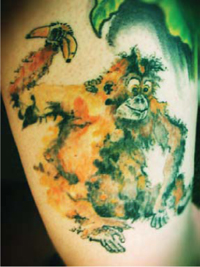
Endangered Species
I N 2009, A CO-OP of artists in Manchester called Ultimate Holding Company celebrated Darwin’s 200th birthday with a three-day tattoo marathon they called “Extinked.” Working with conservation groups, the artists created 100 drawings of endangered animals, plants, and fungi. Over the course of three days, volunteers were tattooed in public with the images by tattoo artists from Ink vs Steel.
Hannah Rosa, a science teacher in London, got a tattoo of the narrow-bordered bee hawk moth, an insect that lives only in the damp grasslands of Britain. “I decided to sign up for the project as I have worked closely with endangered species in the field as part of my degree studies and understand the importance of closely monitoring and preventing the extinction of these species,” she writes. “I wanted to become a life long ambassador so that I can educate others about the impacts of climate change and other human activities, which are threatening hundreds of species in the UK alone.”
Along with the bee, her tattoo includes the closing words of The Origin of Species: “Endless forms most beautiful and most wonderful have been, and are being, evolved.”
Among the other ambassadors are Rachel Holmes (adder, Vipera berus), Sally McGee (rampion bellflower, Campanula rapunculoides), Nicola Steffen (short snouted seahorse, Hippocampus hippocampus), Tim Graham (mole cricket, Gryllotalpa gryllotalpa).

RACHEL HOLMES
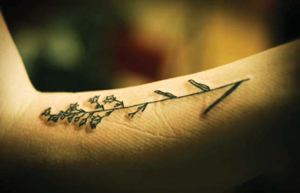
SALLY MCGEE

HANNAH ROSA
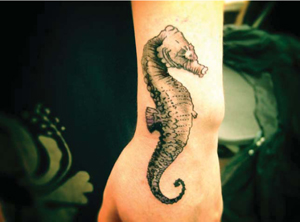
NICOLA STEFFEN
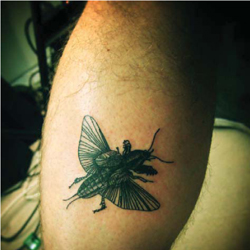
TIM GRAHAM